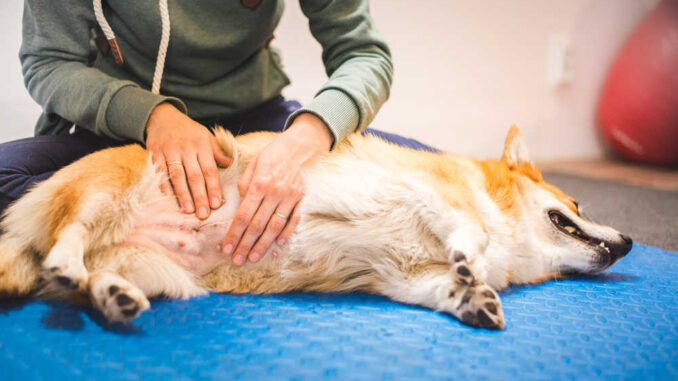
This article was updated on March 14th, 2024
As a dog ages, their body goes through all kinds of changes, their skin included. One of those changes that you may see is the development of age spots. As veterinarians, we see these spots all the time! They are typically harmless, but we will share with you when to be concerned and talk to your vet (with pictures).
Pictures of age spots on dogs
Age spots are flat, darkly pigmented patches that can appear on skin as a dog ages due to the accumulation of pigment called melanin. The picture below shows a natural age spot (skin darkening) on the belly of a 6-year old Terrier mix called Maggie:
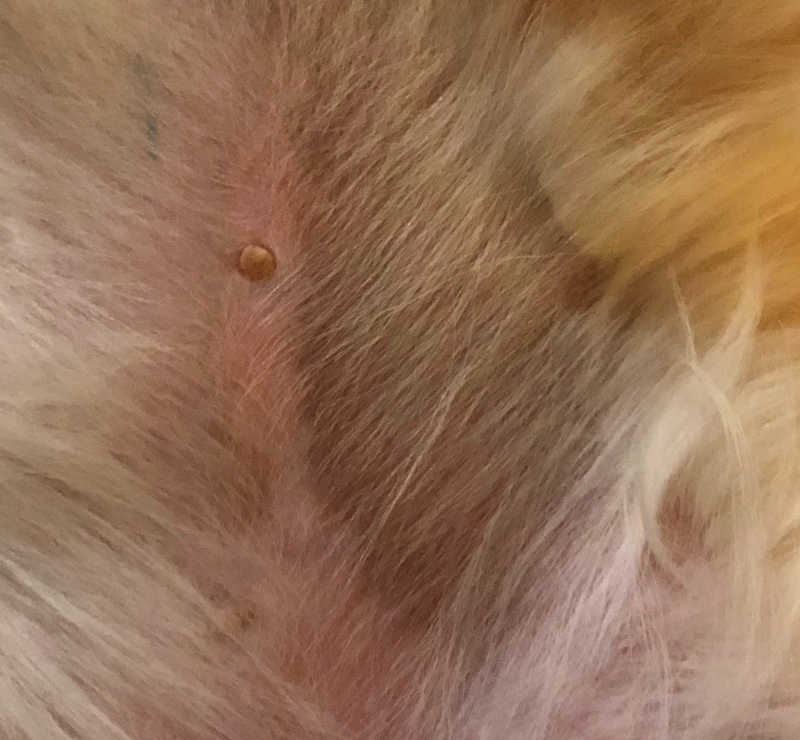
These spots tend to show up in the lighter haired areas of the body, such as the belly, ears, and nose. Keep in mind that if your pup has a thinner hair coat, age spots may show up anywhere.
While they are generally harmless, it’s essential to have any new or unusual brown or black spots on your dog’s skin evaluated by a veterinarian to rule out something concerning! In the next section, we will share when to be worried.
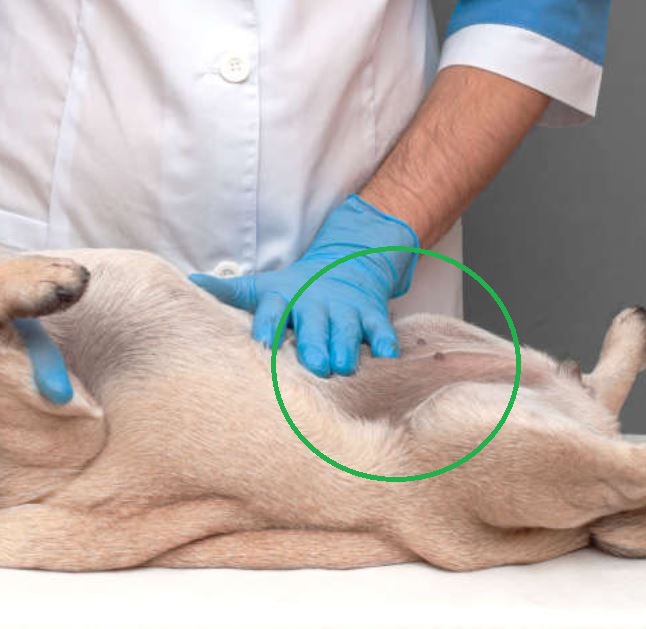
How do I know if I should be worried about my dog’s black spots / age spots?
A lot of skin conditions and problems look alike, so it’s essential to know exactly what is going on with your dog’s skin to help ease the worry but to also catch something that could be a problem – for example a skin infection or an allergy.
If you notice any of the following, it’s best to consult with a veterinarian:
- Rapid growth or change in appearance, such as color change, size, or textural changes
- Irregular borders or shapes (the black spots are not “flat”)
- Bleeding or oozing from the spot
- Redness or inflammation around the spot,
- Any other signs of discomfort like scratching or chewing
Pictures showing examples of problematic dark spots on skin
The 3 pictures below show examples of problematic black spots that are the results of various medical conditions. As you can see, the dark/black spots are slightly raised, the skin appears irritated/red, or the dog is showing other signs of illness (such as flaky skin or hair loss).
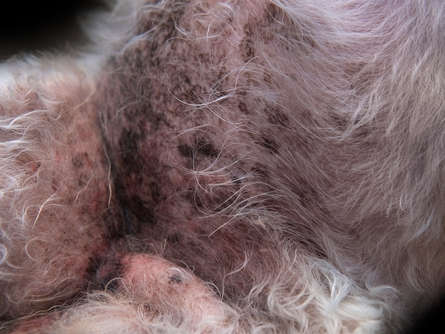
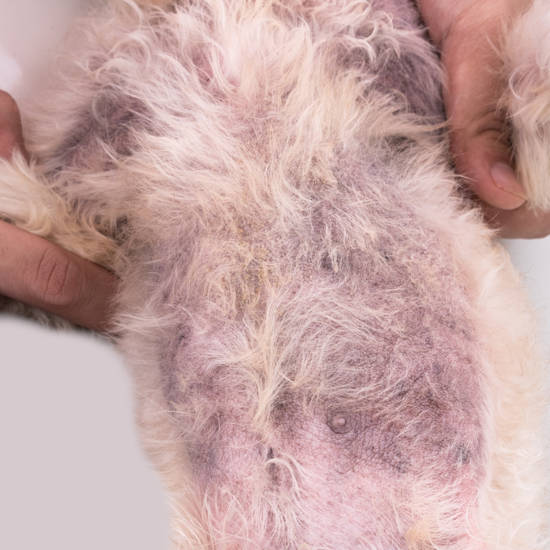
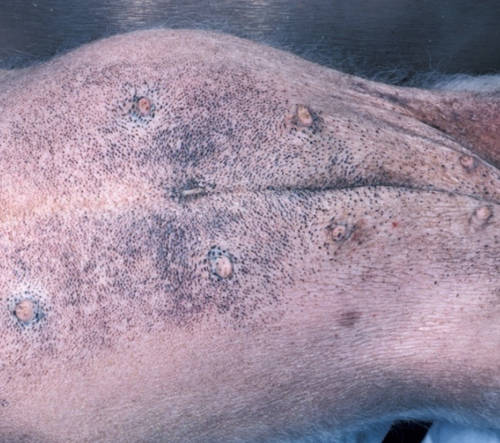
How to diagnose age spots on dogs
Diagnosing age spots can only be properly done by a veterinarian. Even if your dog has a previously diagnosed age spot and another pops up that is very similar, don’t assume. Instead, see your vet. Pictures are helpful but your veterinarian will want to look at the spot directly too.
As a veterinarian, I also use the following diagnostic tests depending on the situation:
1) Cytology: collection of surface skin cells on the spot in question, using a swab or a glass slide (to review under a microscope).
2) Skin scraping: This test goes a little deeper, using a scalpel blade to scrape off surface layers of skin to get to deeper layers. The samples will also be reviewed under a microscope.
3) Needle aspirate: Using a large bore needle, I insert the tip within the skin under the questionable spot. I then use a syringe to “suction” cells out of the middle of the spot. These are also reviewed under the microscope to see which cells make up the spot.
4) Skin biopsy: For larger spots or those that can’t be diagnosed with the previous three tests, there is the option for a skin biopsy. This is a little more involved because sedation or anesthesia is involved, but it will provide a better and deeper sampling of the tissue. The sample is usually sent out to a lab for review.
Learn more about Needle Aspirates & Biopsies.
Additional tests may need to be performed depending on what is found. Your veterinarian may also recommend blood work, skin cultures, or imaging to get the full diagnostic picture.
Age spots are harmless and do not require treatment
However, that doesn’t mean you’re off the hook completely. Instead, you should continue to monitor your dog’s existing spots and any new ones for the following:
- Size: Use a tape or ruler to measure the size of the spot the first time you see it. Record it somewhere safe, like in a note in your phone, and mention it the next time you see your vet.
- Shape: Using a camera and a measuring tape, take a picture of the spot.
- Color: Take several pictures of the spot in different lighting, such as under soft yellow lighting, fluorescent lighting, and outdoor daylight. Use these as a reference point in the future if you think you’ve noticed changes.
This documentation will be helpful during your visit to the veterinarian and can even help your vet with diagnosis. The notes can even be added to your dog’s medical records for future reference.
Frequently Asked Questions
How do age spots differ from other skin conditions?
Age spots are usually simple in appearance and thought to be benign. In contrast, other skin conditions might cause more obvious discomfort, and you may see swelling, discharge, or noticeable changes in appearance over time. Skin conditions with notable discomfort or changes are not likely benign and should not be taken lightly.
What are the pigmentation warning signs to look out for?
Warning signs for skin spots or lumps include rapid growth or changes in appearance, irregular borders (edges that look feathery, fluffy, or anything other than smooth or rounded), bleeding, or inflammation around the spot.
Can I prevent my dog from getting more age spots?
Age spots can be a natural part of the aging process, and there aren’t necessarily prevention measures you should take, unless you have a dog bred to be hairless (or a dog who has lost hair due to another health condition). If your dog has an atypical coat (hairlessness or hair loss), consult with your dog’s veterinarian or a veterinary dermatologist to learn how to protect their uncovered skin.
Disclaimer: This website's content is not a substitute for veterinary care. Always consult with your veterinarian for healthcare decisions. Read More.



Be the first to comment